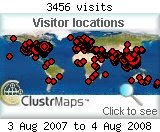Philippine Daily Inquirer
First Posted 04:34:00 04/17/2008
MANILA, Philippines -- There were 88.57 million Filipinos as of Aug. 1, 2007, based on the latest census conducted by the National Statistics Office (NSO).
The results of the Census of Population (Popcen 2007) were made official Wednesday with the signing by President Gloria Macapagal-Arroyo of Proclamation No. 1489.
The Philippine population has swollen from 76.50 million in 2000 and 68.62 million in 1995 based on the 2000 and 1995 census, respectively.
The results of the latest census showed that the country’s average annual population growth rate for the period 2000 to 2007 was 2.04 percent. This was the lowest growth rate experienced by the Philippines since the 1960s.
The average annual population growth rate registered for the period 1960 to 1970 was 3.01 percent.
The population growth rate declined to 2.75 percent from 1970 to 1980, 2.35 percent from 1980 to 1990, and to 2.34 percent from 1990 to 2000.
The NSO expects the average annual population growth rate to further go down to 1.95 percent for the period 2005 to 2010.
Among the 17 administrative regions, Calabarzon (Region IV-A) had the largest population with 11.74 million, followed by the National Capital Region (11.55 million) and Central Luzon (9.72 million). The total population of these three regions comprised more than one-third of the Philippine population. Calabarzon is composed of the Southern Luzon provinces of Cavite, Laguna, Batangas, Rizal and Quezon.
Of the 32 highly urbanized cities, Quezon City had the highest population with 2.68 million. It was followed by Manila (1.66 million) and Caloocan City (1.38 million).
Among the provinces, Cavite had the largest population (2.86 million), followed by Bulacan (2.83 million) and Pangasinan (2.65 million).
Five other provinces -- Laguna, Cebu (excluding the cities of Cebu, Lapu-Lapu and Mandaue), Negros Occidental (excluding Bacolod City), Rizal and Batangas -- breached the two-million mark.
On the other hand, three provinces had fewer than 100,000 residents, namely, Siquijor (88,000), Camiguin (81,000) and Batanes (16,000). Eliza Victoria, Inquirer Research
First Posted 04:34:00 04/17/2008
MANILA, Philippines -- There were 88.57 million Filipinos as of Aug. 1, 2007, based on the latest census conducted by the National Statistics Office (NSO).
The results of the Census of Population (Popcen 2007) were made official Wednesday with the signing by President Gloria Macapagal-Arroyo of Proclamation No. 1489.
The Philippine population has swollen from 76.50 million in 2000 and 68.62 million in 1995 based on the 2000 and 1995 census, respectively.
The results of the latest census showed that the country’s average annual population growth rate for the period 2000 to 2007 was 2.04 percent. This was the lowest growth rate experienced by the Philippines since the 1960s.
The average annual population growth rate registered for the period 1960 to 1970 was 3.01 percent.
The population growth rate declined to 2.75 percent from 1970 to 1980, 2.35 percent from 1980 to 1990, and to 2.34 percent from 1990 to 2000.
The NSO expects the average annual population growth rate to further go down to 1.95 percent for the period 2005 to 2010.
Among the 17 administrative regions, Calabarzon (Region IV-A) had the largest population with 11.74 million, followed by the National Capital Region (11.55 million) and Central Luzon (9.72 million). The total population of these three regions comprised more than one-third of the Philippine population. Calabarzon is composed of the Southern Luzon provinces of Cavite, Laguna, Batangas, Rizal and Quezon.
Of the 32 highly urbanized cities, Quezon City had the highest population with 2.68 million. It was followed by Manila (1.66 million) and Caloocan City (1.38 million).
Among the provinces, Cavite had the largest population (2.86 million), followed by Bulacan (2.83 million) and Pangasinan (2.65 million).
Five other provinces -- Laguna, Cebu (excluding the cities of Cebu, Lapu-Lapu and Mandaue), Negros Occidental (excluding Bacolod City), Rizal and Batangas -- breached the two-million mark.
On the other hand, three provinces had fewer than 100,000 residents, namely, Siquijor (88,000), Camiguin (81,000) and Batanes (16,000). Eliza Victoria, Inquirer Research













0 comments:
Post a Comment